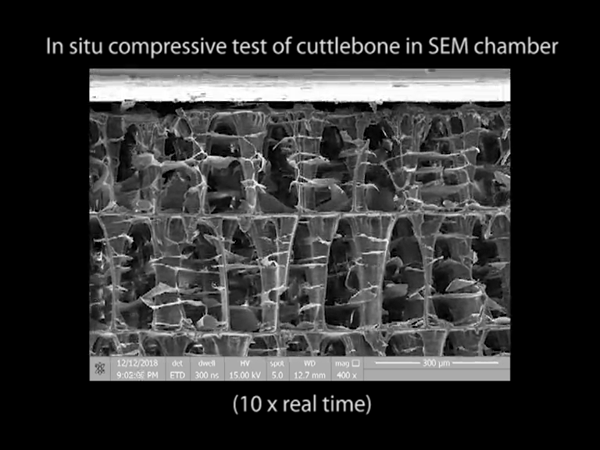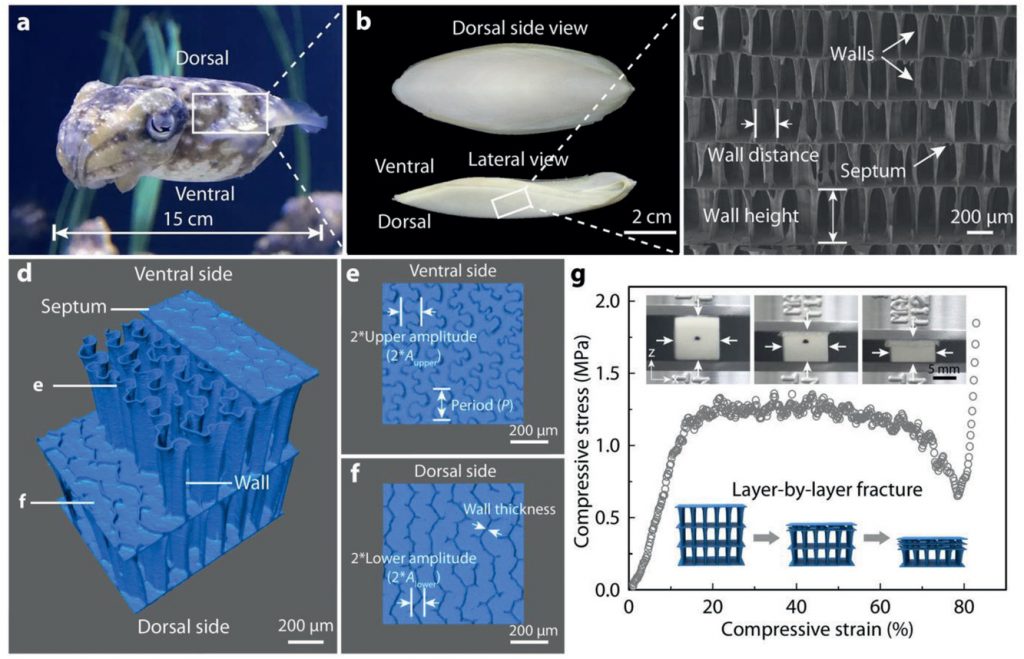Researchers from the Chinese Zhejiang University have developed a set of novel biomimetic cell-like structures with unique energy absorption capabilities.
Inspired by the rigid yet flexible skeleton of the cuttlefish, the scientists’ 3D printed models proved ultra-resistant to compression, and capable of withstanding up to 20,000 times their own weight in deformation. In future, the team believe that their design could be replicated elsewhere to develop new lightweight impact-proof materials, with applications ranging from aerospace builds to armor plating.
“With the best performance, cuttlebone‐like cellular materials are an outstanding candidate for applications in many fields such as aircraft, body armor, lightweight vehicles, and building materials,” said the scientists in their paper. “They provide a new biological design for a mechanically-efficient cellular structure, beyond conventional mechanical metamaterials.”

Nature-inspired 3D printing
The natural world is filled with examples of materials like bamboo, balsa wood, and certain animal bones, that are ultra-lightweight yet feature extremely durable cellular structures. In terms of rigidity though, the cuttlefish possesses a particularly extraordinary porous skeleton, which is capable of resisting huge levels of hydrostatic pressure in deep‐sea environments, by changing its buoyancy at different depths.
In an attempt to identify the precise source of the cuttlefish’s deformation capabilities, the scientists therefore opted to carry out micro‐CT scans of a cuttlebone specimen. Under compression, the team found that the sample fractured successively from one layer to another, but when the top ones were damaged its bottom layers remained intact, in a mechanism that’s designed to protect cuttlefish from predatory attacks.
More importantly, the researchers also uncovered the role of the naturally-occuring aragonite mineral in the sea creature’s defense mechanism, as well as its overall S-shaped lamellae structure. Using this information in subsequent experiments, the team set about 3D printing cellular materials with a cuttlebone‐like architecture, which best mimicked both the shape and formation of the genuine article.

Impact-resistant biomimetic models
In order to assess the cuttlebone’s mechanics in greater depth, the scientists 3D printed five biomimetic layouts: an octet‐truss lattice, kelvin foam, gyroid structure, kelvin sandwich, and honeycomb sandwich panel. Each structure featured simplified versions of the layers seen in real cuttlefish, with interconnected walls mimicking their organic elements.
During early testing, all of the polymeric prototypes buckled under compression, but the team found that the shape of a specimens’ walls made a huge difference to their resistance. In fact, compared to other conventionally-shaped parts, the scientists had to apply much greater pressure to the cuttlebone‐like prototypes to make them collapse side-on.
Building on these initial findings, the researchers then formulated a range of cellular materials, which better mimicked cuttlebone’s architecture and mechanical behaviors. Compared to conventional polymeric foams, the prototypes demonstrated 20-25 times more energy absorption, and they ultimately proved capable of being run over by an entire car without losing their structural integrity.
At the study’s conclusion, the team highlighted how 3D printing had provided them with the design freedom needed to unlock the potential of their biomimetic material, and suggested that using ceramics or metals in future, it could be possible to create reinforced structures with even greater resistance qualities.
“With low-weight, high-strength, and excellent energy‐absorption ability, this bio-inspired cellular material may find wide applications in such as aerospace structures and implantable devices,” concluded the researchers in their paper. “Our study highlights the possibility of design and engineering of high‐performance cellular materials, through bio-inspired 3D printing.”
Advances in load-bearing lattices
While the high strength-to-weight ratio of latticed 3D printed parts is well-known within the industry, scientists continue to find ways of generating novel designs.
Like the Zhejiang scientists, researchers from the National Taiwan University of Science and Technology have also taken a marine-inspired approach to creating a novel load-bearing material. Based on the morphology of the sea urchin, the team’s mechanically-stable FDM filament doesn’t require the use of any support structures during printing.
Similarly, Phoenix Analysis & Design Technologies has been awarded $755,000 in NASA funding to help develop stronger and lighter structures for use during space exploration. Specifically, the firm has been given the research grant to create a software tool for designing, testing and 3D printing strong, lightweight, bio-inspired lattices for aerospace vehicles.
Elsewhere, engineers at UC Berkeley have demonstrated the benefits of incorporating 3D printed polymer octet lattices into concrete structures. By integrating plastic into their printing material, the team found that they could reduce the weight of load-bearing structures, without diminishing their durability.
The researchers’ findings are detailed in their paper titled “Mechanically Efficient Cellular Materials Inspired by Cuttlebone,” which was co-authored by Anran Mao, Nifang Zhao, Yahui Liang and Hao Bai.
To stay up to date with the latest 3D printing news, don’t forget to subscribe to the 3D Printing Industry newsletter or follow us on Twitter or liking our page on Facebook.
Are you looking for a job in the additive manufacturing industry? Visit 3D Printing Jobs for a selection of roles in the industry.
Featured image shows a cuttlefish within its natural habitat. Photo via Francis Nie, Unsplash.


